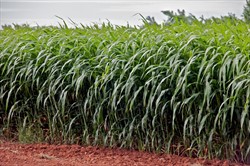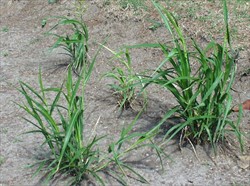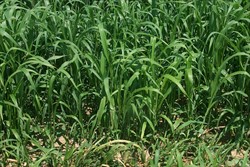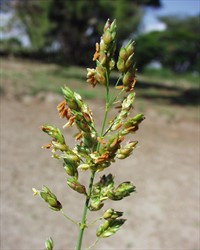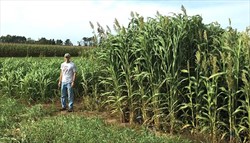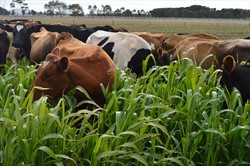Sorghum (annual)
Tropical Forages
Sorghum bicolor (L.) Moench
Subordinate taxa:
Sorghum bicolor (L.) Moench subsp. bicolor
Sorghum bicolor (L.) Moench nothosubsp.* drummondii (Steud.) de Wet ex Davidse
Sorghum bicolor (L.) Moench subsp. verticilliflorum (Steud.) de Wet ex Wiersema & J. Dahlb.
*Note: "notho" denotes a hybrid formed by direct hybridization of two subspecies, not other hybrids - in this case between subsp. bicolor and subsp. verticilliflorum.
subsp. bicolor: Basionym: Holcus bicolor L.; Andropogon sorghum (L.) Brot.; Andropogon sorghum subvar. japonicus Hack.; Andropogon sorghum subvar. rubidus Burkill ex C. Benson & C.K. Subba Rao; Andropogon sorghum var. agricolarum Burkill ex C. Benson & C.K. Subba Rao; Andropogon sorghum var. arduinii Körn.; Andropogon sorghum var. caudatus Hack.; Andropogon sorghum var. compactus Burkill ex C. Benson & C.K. Subba Rao; Andropogon sorghum var. ehrenbergianus Körn.; Andropogon sorghum var. elegans Körn.; Andropogon sorghum var. hians Stapf; Andropogon sorghum var. lasiorhachis Hack.; Andropogon sorghum var. miliiformis Hack.; Andropogon sorghum var. splendidus Hack.; Andropogon sorghum var. subglobosus Hack.; Andropogon sorghum var. technicus Körn.; Andropogon subglabrescens Steud.; Holcus cernuus Ard.; Holcus dochna Forssk.; Holcus durra Forssk.; Holcus saccharatus L.; Holcus sorghum L.; Milium nigricans Ruiz & Pav.; Panicum caffrorum Retz.; Sorghum basutorum Snowden; Sorghum bicolor var. arduinii (Körn.) Snowden; Sorghum bicolor var. subglobosum (Hack.) Snowden; Sorghum bicolor var. technicum (Körn.) Stapf ex Holland; Sorghum caffrorum (Thunb.) P. Beauv.; Sorghum caffrorum var. brunneolum Snowden; Sorghum caffrorum var. lasiorhachis (Hack.) Snowden; Sorghum caudatum (Hack.) Stapf; Sorghum cernuum (Ard.) Host; Sorghum cernuum var. agricolarum (Burkill ex C. Benson & C.K. Subba Rao) Snowden; Sorghum cernuum var. orbiculatum Snowden; Sorghum conspicuum Snowden; Sorghum conspicuum var. pilosum Snowden; Sorghum conspicuum var. rubicundum Snowden; Sorghum coriaceum Snowden; Sorghum coriaceum var. subinvolutum Snowden; Sorghum dochna (Forssk.) Snowden; Sorghum dochna var. technicum (Körn.) Snowden; Sorghum durra (Forssk.) Stapf; Sorghum elegans (Körn.) Snowden; Sorghum gambicum Snowden; Sorghum guineense Stapf; Sorghum japonicum (Hack.) Roshev.; Sorghum margaritiferum Stapf; Sorghum melaleucum Stapf; Sorghum mellitum Snowden; Sorghum membranaceum Chiov.; Sorghum membranaceum var. ehrenbergianum (Körn.) Snowden; Sorghum miliiforme (Hack.) Snowden; Sorghum nervosum Chiov.; Sorghum nervosum Besser ex Schult. & Schult. f.; Sorghum nigricans (Ruiz & Pav.) Snowden; Sorghum notabile Snowden; Sorghum roxburghii Stapf; Sorghum roxburghii var. hians (Stapf) Stapf; Sorghum saccharatum (L.) Moench; Sorghum simulans Snowden; Sorghum splendidum (Hack.) Snowden; Sorghum subglabrescens (Steud.) Schweinf. & Asch.; Sorghum subglabrescens var. compactum (Burkill ex C. Benson & C.K. Subba Rao) Snowden; Sorghum subglabrescens var. oviforme Snowden; Sorghum subglabrescens var. rubidum (Burkill ex C. Benson & C.K. Subba Rao) Snowden; Sorghum technicum Batt. & Trab.; Sorghum vulgare Pers.; Sorghum vulgare var. caffrorum (Retz.) F.T. Hubb. & Rehder; Sorghum vulgare var. durra (Forssk.) F.T. Hubb. & Rehder; Sorghum vulgare var. roxburghii (Stapf) Haines; Sorghum vulgare var. saccharatum (L.) Boerl.; Sorghum vulgare var. technicum (Körn.) Fiori & Paol.
nothosubsp. drummondii: Basionym: Andropogon drummondii Steud.; Andropogon sorghum subsp. hewisonii Piper; Andropogon sorghum subsp. sudanensis Piper; Andropogon sorghum var. drummondii (Steud.) Hack.; Holcus sorghum var. hewisonii (Piper) Hitchc.; Holcus sorghum var. sudanensis (Piper) Hitchc.; Sorghum bicolor var. drummondii (Steud.) Mohlenbr.; Sorghum hewisonii (Piper) Longley; Sorghum niloticum (Stapf ex Piper) Snowden; Sorghum sudanense (Piper) Stapf; Sorghum vulgare var. drummondii (Steud.) Hitchc.; Sorghum vulgare var. sudanense (Piper) Hitchc.; Sorghum × drummondii (Steud.) Nees ex Millsp. & Chase
subsp. verticilliflorum: Basionym: Andropogon verticilliflorus Steud.; Andropogon arundinaceus Willd.; Andropogon sorghum subsp. vogelianus Piper; Andropogon sorghum var. aethiopicus Hack.; Andropogon sorghum var. effusus Hack.; Andropogon sorghum var. virgatus Hack.; Andropogon stapfii Hook. f.; Holcus sorghum var. effusus Hitchc.; Holcus sorghum var. verticilliflorus (Steud.) Hitchc.; Rhaphis arundinacea Desv.; Sorghum aethiopicum (Hack.) Rupr. ex Stapf; Sorghum arundinaceum (Desv.) Stapf; Sorghum bicolor subsp. arundinaceum (Desv.) de Wet & J.R. Harlan ex Davidse; Sorghum brevicarinatum Snowden; Sorghum lanceolatum Stapf; Sorghum macrochaeta Snowden; Sorghum pugionifolium Snowden; Sorghum stapfii (Hook. f.) C.E.C. Fisch.; Sorghum usambarense Snowden; Sorghum verticilliflorum (Steud.) Stapf; Sorghum virgatum (Hack.) Stapf; Sorghum vogelianum (Piper) Stapf
Family: Poaceae (alt. Gramineae) subfamily: Panicoideae tribe: Andropogoneae subtribe: Sorghinae.
subsp. bicolor: Variable, robust tufted annual or short-lived perennial, with unbranched culms 0.5‒4 (‒6) m tall and 5‒ >30 mm diameter depending on variety and growing conditions, usually with well-developed prop roots; nodes mostly puberulent to shortly pilose. Leaf sheaths usually glabrous; leaf blades flat, linear, apex tapering, (12‒) 30‒60 (‒135) cm long, and 1‒5 (‒13) cm wide, usually glabrous and waxy, the midrib prominent and pale, margins scabrous; ligule chartaceous, 1.5‒5.5 mm long. Panicle erect, sometimes recurved, usually compact in grain sorghums and more open in forage types, 10‒25 (‒40) cm long; sessile spikelet broadly obovate, 4‒6 mm long, 3‒4.5 mm wide, glumes pubescent, lemma of upper floret without awn; pedicellate spikelets usually sterile, rarely staminate, narrowly lanceolate, 4‒5 (‒6) mm long; caryopsis ellipsoid to obovoid or globose dorsiventrally compressed, 3‒4 mm diameter, white, yellow, orange, reddish or reddish brown, exposed distally through glumes at maturity. 25,000‒60,000 seeds per kg.
nothosubsp. drummondii: Leafy, erect tufted annual with numerous, sparsely branched culms to 3 m tall, 3‒9 mm thick, often with prop roots, but no rhizomes; nodes pubescent. Leaves numerous; leaf sheaths largely glabrous; leaf blade linear, apex attenuate, 15‒30 (‒60) cm long and 8‒15 (‒25) mm wide, glabrous; ligule membranous, about 2 mm long. Panicle twice as long as broad, ovoid-pyramidal, open, 15‒35 (‒75) cm long, with secondary and sometimes tertiary branches; spikelets paired; sessile spikelet 5.5‒7.5 mm long, upper portion of the rachis internode attached when the spikelets finally fall; glumes sparsely hairy, shiny and almost hairless when mature; lemma of upper floret with awn to 16 mm long and twisted at base; pedicellate spikelet about as long as the sessile spikelet, but narrower. Caryopsis variable, enclosed by the glumes; grain not exposed at maturity. 120,000 seeds per kg.
subsp. verticilliflorum: Erect, loosely tufted, short-lived perennial or annual to 4 m tall, with distinct prop roots but without rhizomes; culms mostly unbranched, nodes glabrous or pubescent. Leaf sheaths glabrous; leaf blades linear, to 60 cm long, 0.8‒3 cm wide, glabrous, apex attenuate. Panicle lanceolate to broadly spreading, 10‒60 cm long; sessile spikelet narrrowly ovate to elliptic (4‒) 5.5‒7.5 (‒9) mm long, breaking away cleanly from rachis internodes when falling; glumes hairy at least when young, often becoming less hairy with age, lemmas of both florets ciliate, lemma of upper floret awnless or with awn 5‒30 mm long, twisted at the base; pedicellate spikelet linear to lanceolate, male or barren, smaller than the sessile spikelet.
Sorghum bicolor
English: great millet, Rhodesian Sudan grass; sorghum
Africa: vernacular names used in the African countries are too numerous to list
subsp. bicolor
Africa: graansorghum, voersorghum (Afrikaans); mailamucheme, makonga, mabele, chiganigani (Zambia); tinkish (Amharic, Ethiopia), ala (Oromo, Ethiopia); bachanta, mashila (Ethiopia); mtama (Kenya); ipwa (Shona); aura (Sudan); duhn, durah (Arabic, Egypt); dura (Sudan)
Asia: : 高粱 gao liang, kaoliang; 弯头高粱 wan tou gao liang; 甜高粱 tian gao liang;多脉高粱 duo mai gao liang (China); morokoshi, satou morokoshi (satô morokoshi), sorugamu (Japan); susu (Korea); cantel, jagung cantel (Indonesia); shallu (Myanmar)
English: broomcorn, durra, feterita, forage sorghum, grain sorghum, great millet, guinea corn, Kaffir-corn, milo, milo-maize, shallu, sorghum, sweet sorghum
Europe: kafferkoren (Dutch); gros mil, riz Égyptien, sorgho (French); gewöhnliche Mohrenhirse, Hirse, Mohrenhirse, Kaffernhirse, nickende Mohrenhirse, Zuckerhirse (German); sorgo, sorgo coltivato (Italian); sorgo, sorgo forrageiro (Portuguese); daza, sorgo, maiz guineo, millo, sorgo comun, sorgo de grano (Spanish); durra (Swedish)
India: zu, zuwar (Assamese); jowari (Bengali); chari, jowar (Hindi); jawari (Hindustani); /ಜೋಳ jola (Kannada); ज्वारी jwari, jondhala (Marathi); juara (Oriya); cholam, cholum, solam (Tamil); jannalu, jonna (Telugu)
Latin America: capim massambará, mapira, massamba, milho da Guiné, sorgho, sorgho das vassouras, sorgho de espiga (Portuguese); challu, kafir, millo de Africa, pajón, sorgo blanco, sorgo de escoba (Spanish)
nothosubsp. drummondii
Africa: garawi (Sudan)
Asia: su dan cao, gao liang su dan, cao za jiao zhong (Chinese); chikinkoo, suudan gurasu (Japanese); batag, bukakau, layagah (Philippines); ya-sudan (Thai); sudan otu (Turkish)
English: Sudan grass, chicken-corn, shattercane, sordan, sorghum-sudangrass
Europe: soedangras (Dutch); sorgho adventice, sorgho du Soudan, sorgho menu (French); sudanisches Sorghogras, Sudangras, Sudanhirse (German); erba sudanese, erba di sudan, sorgo gentile (Italian); hierba del sudan, pasto sudán (Spanish); sudangräs (Swedish)
Latin America: capim Sudão (Brazil); hierba del Sudán, pasto del Sudán, pasto Sudán, sorgo de Sudán, sorgo sudán forrajero, zacate Sudán (Spanish)
subsp. verticilliflorum
English: common wild sorghum, wild sudan grass
Brazil: sorgo-selvagem
Sorghum bicolor
Native:
Africa: Angola; Benin; Botswana; Burkina Faso; Cameroon; Central African Republic; Chad; Côte d'Ivoire; Democratic Republic of the Congo; Egypt; Ethiopia; Equatorial Guinea; Gabon; Gambia; Ghana; Guinea; Kenya; Liberia; Malawi; Mali; Mauritania; Mozambique; Namibia, Niger; Nigeria; Senegal; Sierra Leone; Somalia; South Africa; Sudan; Swaziland; Tanzania; Uganda; Zambia; Zimbabwe
Cultivated:
Throughout tropical, subtropical, & warm-temperate regions
Naturalized:
Asia: India
Australasia: Australia
America: North America, Central America, South America
subsp. bicolor
Cultivated: throughout tropical, subtropical, & warm-temperate regions
nothosubsp. drummondii
Cultivated: one form (Sudangrass) widely cultivated for forage
Naturalized: may occur as a weed wherever sorghum is cultivated
subsp. verticilliflorum
Native:
Africa: Angola; Benin; Botswana; Burkina Faso; Cameroon; Central African Republic; Chad; Côte d'Ivoire; Democratic Republic of the Congo; Egypt; Ethiopia; Equatorial Guinea; Gabon; Gambia; Ghana; Guinea; Kenya; Liberia; Malawi; Mali; Mauritania; Mozambique; Namibia, Niger; Nigeria; Senegal; Sierra Leone; Somalia; South Africa; Sudan; Swaziland; Tanzania; Uganda; Zambia; Zimbabwe
Naturalized:
Asia: India
Australasia: Australia
Northern America: North America
Southern America: South America; Central America
Forage
Subsp. bicolor: Sweet sorghum varieties and inter- and intra-specific hybrids with Sudan grass have been developed for grazing and/or silage. Sorghum grain is a significant component of cattle, pig and chicken feeds in the United States, Central and South America, Australia and China, and is becoming important in chicken feed in India. It requires grinding, rolling, flaking or steaming to maximize its nutritional value.
Nothosubsp. drummondii: Cultivated primarily for hay or as a pioneer grass, although seldom used for silage. Valued in areas with hot dry summers for ease or establishment and for its ability to recover after grazing or cutting.
Other
Subsp. bicolor: Grown for grain, syrup and sugar, and industrial uses of stems and fibres. Sorghum grain is used for human food, and for the preparation of fermented beverages, alcohol and vinegar.
Subsp. verticilliflorum: Source of genetic material for breeding programmes.
Soil requirements
subsp. bicolor: Adapted to wide range of at least moderately well-drained soils, with textures from light loams to heavy clays; best on very fertile, moderately acid to slightly alkaline (pH (4.5‒) 5.7‒7 (‒8.7)), deep, friable soils. Performance suffers in sandy soils of high pH. Moderately salt tolerant, growing in soils with salinity levels up to 10 dS/m.
nothosubsp. drummondii: Adapted to wide range of soils from heavy clays (not cold and wet) to sands, but requires fertile land to give high yields. Does not tolerate alkaline, saline, or solonetz soils.
Moisture
Adapted to tropical and subtropical summer rainfall climate with (300‒) 500‒1,000 (‒2,000) mm of rain annually. Leaf disease is more prevalent under high rainfall conditions. Its deep rooting can extract water from low sources, though not as deep as Cenchrus americanus (pearl millet). While sweet sorghum will survive on less than 300 mm of rain over a season, 500 to 1,000 mm of rain and/or irrigation is necessary to obtain good yields (50 to 100 t total green weight). It resists drought by becoming dormant under adverse moisture conditions and resuming growth when moisture is available. Shoot removal lowers its capacity to withstand drought. Early drought stops growth before floral initiation and the plant remains vegetative; it will resume leaf production and flower when conditions again become favourable for growth. Late drought stops leaf development but not floral initiation. Sorghum is intolerant of sustained flooding, but will survive temporary waterlogging. Nothosubsp. drummondii does not thrive in the humid tropics or in cool humid temperate conditions.
Temperature
S. bicolor is a warm season plant and seed should be planted when soil temperatures are above 15 °C. Most favourable temperature for growth ranges from 25 to 30 °C. Grows well under irrigation in hot dry regions. Because there are cold-tolerant types, it can be grown to 40º N and S of the Equator. In the tropics it can be grown to 2,200 m asl, but is more commonly grown below about 1,000 m asl. As very fast-growing annuals, they can be grown wherever the growing season is long enough – from adequate soil temperature to end of wet season. Sorghum is very susceptible to frost, but thick-stemmed, standing, sweet fodder sorghum will retain stem juiciness and sweetness for some time after the leaves are killed. Sudangrass does not tolerate frost and is killed when the temperature drops to 3‒5 °C below the freezing point.
Light
S. bicolor grows best with full sunlight. It has a high radiation use efficiency and is in fact one of the most radiation-efficient crops. Conversely, it is intolerant of shade.
Reproductive development
S. bicolor exibits a short-day flowering response, and normally flowers 8 to 10 weeks after germination in warm climates, but depending on genotype, flowering may occur 4 to 14 weeks after germination. Wet and cool weather can delay flowering. Flowers begin to open 2 days after emergence of the inflorescence from the boot. Flowering starts in the sessile spikelets at the tip of the inflorescence and progresses downwards over 4‒5 days.
Defoliation
Sudan grass and sudan grass hybrids are better suited to heavy grazing due to better regrowth potential and lower prussic acid (hydrogen cyanide) levels than grain or sweet sorghum hybrids. Having a high level of residual coarse stems remaining after grazing can be avoided by grazing early, i.e. grazing heavily when plants reach 50‒60 cm high to prevent development of coarse stems and early flowering. Below 50 cm, the risk of prussic acid poisoning increases considerably. It should not be grazed below 15‒20 cm to facilitate good regrowth. Thereafter, the stand can be allowed to grow a little taller, to 1 or 1.5 m between grazings. Forage sorghum can make high quality hay provided stems are not thick and woody, best achieved by selecting fine-stemmed varieties and increasing plant density (i.e. sowing rate). Sugardrip and sweet sorghum hybrids provide the most palatable standover feed.
Fire
Not normally subjected to fires.
Guidelines for establishment and management of sown forages.
Establishment
Planted 2–5 cm deep into arable seedbed at 4–10 kg/ha seed when soil temperature is rising and exceeds about 15 °C. Higher sowing rates can be used for irrigated stands and for hay crops. Large seed and germinates and establishes vigorously.
Fertilizer
Should be grown only on fertile soils and so would need additional nitrogen on soils of marginal soil fertility. In general, crops require at least 20 kg/ha phosphorus and sulphur and 100 kg/ha nitrogen, particularly on less-fertile soils. N can be applied where irrigation or adequate soil moisture is available, but the plants can quickly grow past the optimum stage without careful grazing management. Excessive nitrogen fertilizer favours high levels of toxic prussic acid (HCN) in young growth of some varieties, and can also lead to nitrate poisoning if growth is slowed by dry or cold.
Compatibility (with other species)
May be sown with summer-growing legumes, but as these generally grow more slowly than the sorghum, it is difficult to find the optimal stage or frequency of grazing for the mixture.
Companion species
Legumes: Lablab purpureus, Vigna unguiculata.
Pests and diseases
Numerous fungal and viral diseases afflict sorghums, often not causing serious damage. The effects of fungal diseases such as ergot caused by Claviceps africana, head smut caused by Sporisorium reilianum, and leaf blight caused by Exserohilum turcicum, as well as viral diseases such as the leaf mosaic caused by Johnson Grass Mosaic Virus can be minimized by using genetically resistant varieties that are constantly being developed. Ergot in grazed or hay crops can be controlled by grazing or harvesting before flowering. Resistance or tolerance to the effects of the obligate hemiparasite, witchweed (Striga hermonthica and Striga asiatica), has also been identified resulting in development of suitable cultivars for striga infested areas. Push-pull technology has been developed by ICIPE to reduce the impact of witchweed as well as of stem borers (Chilo partellus, Eldana saccharina, Busseola fusca and Sesamia calamistis). The strategy involves combined use of intercrops and trap crops, using plants that are appropriate to the farmers. Repellent intercrop "push" plants deter the pest from the main crop, while the trap "pull" plants have the inherent ability of not allowing development of trapped stemborers, thus reducing the number of trapped insects.
Ability to spread
The grassy types, nothosubsp. drummondii and subsp. verticilliflorum have some propensity to spread and are often found as weeds in protected land. While both cross readily with var. bicolor, the crosses pose a low risk of becoming a weed as they are generally sterile or have very low fertility.
Weed potential
These annual subspecies are generally considered to pose a low weed risk in most situations. The same cannot be said for the perennial Sorghum spp. Shattercane, a weedy race of nothosubsp. drummondii, has been declared noxious in a number of states of the USA.
Nutritive value
Nutritive value greatly depends on stage of growth and soil fertility. As with all grasses, nutritive value is highest when the plant is leafy and declines rapidly through flowering to maturity. Nutritive value also depends greatly on soil fertility or the amount of fertilizer applied, and on grazing management where best results are achieved with a grazing height of 1‒1.2 m. At this height, crude protein levels could be as high as 18% with energy levels of 8.8‒9.5 MJ/kg DM.
Palatability/acceptability
Moderately palatable and digestible when young. The sweet sorghum hybrids keep a higher free sugar content in the stem and are more suitable as stand-over feed into winter or the dry season. The various types of hybrids have different agronomic features and uses:
- Sweet sorghum hybrids tiller well, are tall with fine stems, flower early and have low prussic acid.
- Sweet sorghum × Sudan grass hybrids are more compact and leafy with more juicy and sweet stems. Prussic acid levels are low. They grow rapidly but some cultivars selected for later flowering are easier to manage as they remain leafy for longer.
- Sweet sorghum × sweet sorghum hybrids are tall, late flowering with high sugar levels in their stems. Prussic acid levels are high. More suitable as stand-over feed into autumn.
Toxicity
Leaves can be poisonous to grazing livestock due to the presence of hydrocyanic acid (prussic acid, HCN), especially in young dark-blue coloured regrowth after a dry spell. Having supplement blocks containing sulphur available will reduce the risk of prussic acid poisoning. Excessive nitrogen fertilizer favours high levels of HCN in young growth of some varieties, and can also lead to nitrate poisoning if growth is slowed by dry or cold.
Feedipedia link
https://www.feedipedia.org/node/379 (subsp. bicolor)
https://www.feedipedia.org/node/375 (nothosubsp. drummondii)
Dry matter
DM yields depend strongly on temperature, soil fertility and soil moisture availability, but can be up to 30 t/ha/yr under ideal conditions. Yields are generally of the order of (10‒) 15‒20 t/ha/yr DM.
Animal production
Generally, liveweight gains vary between 0.5 and 1.0 kg per head per day depending on plant height and leafiness.
2n = 20. S. bicolor is predominantly self-pollinating, but under specific conditions wind-mediated cross-pollination can occur. The level of outcrossing varies and is influenced by the panicle type of the cultivar; typically outcrossing is higher in loose-panicled nothosubsp. drummondii and subsp. verticilliflorum, and lower in compact-panicled subsp. bicolor. Nothosubsp. drummondii is a natural hybrid between subsp. bicolor and subsp. verticilliflorum. Plant breeding continues to improve pest and disease resistance, as well as to develop later flowering varieties. S. bicolor crosses readily with S. propinquum, producing hybrids that might extend the range of grain sorghum into more temperate regions.
Subspecies bicolor can produce seed yields of 3‒5 t/ha. Seed does not shatter readily and can be harvested easily. No dormancy.
Since seed of ‘Silk’ (perennial Sorghum hybrid) and that of the noxious weed, S. halepense, are of similar colour to S. bicolor, care must be taken with the purity of seed crops.
In the U.S., volunteer S. bicolor is controlled with herbicides including clethodim (group 1), fluazifop (group 1), imazethapyr (group 2), primisulfuron (group 2), dicamba (group 4), atrazine (group 5), glyphosate (group 9), and S-metolachlor (group 15), alone or in mixtures. Atrazine may be used as a pre-emergence herbicide for grass and broadleaf weed control with care with some hybrids (see label recommendations) but not with sudan grass. Seedlings and young plants are easily eradicated with non-residual contact herbicides such as glyphosate.
- Easy establishment and rapid growth.
- Very productive on fertile soils.
- Pioneer species with other perennial grasses or legumes.
- Demands high soil fertility.
- Prussic acid poisoning.
- Seed cannot be distinguished from that of S. halepense.
- Strips nitrogen from marginal soils making it difficult to plant following permanent pasture.
- Difficult to eradicate from subsequent grain crops.
Bogdan, A.V. (1977) Tropical Pasture and Fodder Plants. Longman Inc., New York, USA. p. 269–282.
Stuart, P.N. (2002) The Forage Book: A comprehensive guide to forage management. 2nd edition. Pacific Seeds, Toowoomba, Queensland, Australia.
Wiersema, J.H. and Dahlberg, J. (2007) The Nomenclature of Sorghum bicolor (L.) Moench (Gramineae) Taxon 56:941–946.
Numerous cultivars have been developed for specific purposes (grazing, hay, silage, standover feed), according to the needs of farmers in the various countries where annual forage sorghums are grown.
There are no promising accessions as such.
